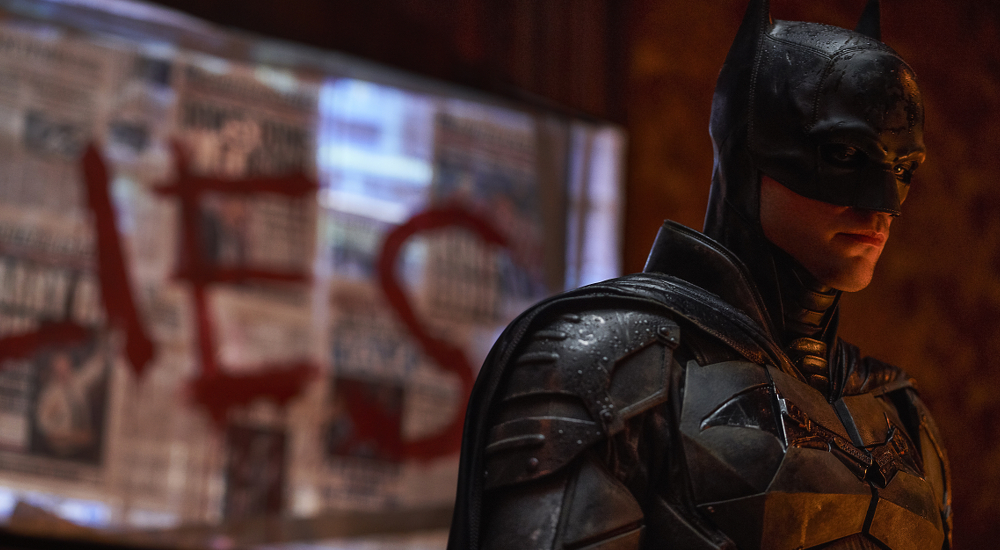"I'm vengeance."
Bruce Wayne has been a mainstay in cinemas since Michael Keaton embodied the iconic comic book character in 1989. Originally created by Bob Kane and Bill Finger, the billionaire vigilante has been deconstructed to the brink of extinction. So how is Robert Pattinson's collaboration with director Matt Reeves fresh and different? How is The Batman forging a new path in the world of Gotham? Authenticity.
The opening minutes of the film set the tone. It's a dark and rainy Thursday. Halloween night. A crescendo of events showcases a run of crime that filters through the city streets. A haunting voiceover sets the stage as Batman speaks of Gotham's growing crime. He can't be everywhere, but a confrontation in the subway with a band of criminals awakens our senses. There is little mercy behind the mask.
Dark and unforgiving, The Batman offers us a new look at Gotham. Picking up during the Caped Crusader's second year of vigilante work, Reeves spares us the origin story, skipping forward to showcase a man comfortable in his role working within a city that knows his potential. An occasional callback reminds us of critical moments in Bruce Wayne's past, but Reeves successfully maneuvers the history, highlighting the crucial points, grounding the story in the present.
Wayne Enterprises, often a character unto itself, is rarely mentioned. Neither is Alfred (Andy Serkis). Bruce Wayne's butler and Batman's most trusted confidant gets limited screen time as this story takes place within the streets of Gotham, not at home amid the quiet and serene.
More a crime thriller than an outright comic book adaptation, Reeves embraces his moment, allowing scenes to linger as he prioritizes his style. His use of electric hues delivers incredible visuals, notably when Batman and Catwoman (Zoë Kravitz) stand on an exposed terrace, the Gotham skyline behind them in the distance. Visually stimulating, the camera work gives the city grit as Pattinson's Batman moves in and out of shadows, bringing a sense of law and order to the streets.
Featuring a script that is, at times, laden with dialogue, Reeves occasionally spells things out in mass detail, hemorrhaging the flow of information as the story becomes layered with complexity. Batman himself is one of the only characters of few words. Though the low, harsh delivery that has haunted past incarnations remains consistent, his actions do most of the talking as he keeps to the shadows.
Paul Dano scores high marks for his work as the Riddler. Near flawless in both concept and execution, the villain is presented as a sadistic serial killer making quick work of Gotham's corrupt officials. Hidden from viewers for much of the film, Dano works miracles as he pushes the narrative forward with his allusive presence. The horror of his potential is a constant thought in the rear of your mind as he generates a similar sense of discomfort to Heath Ledger's work in The Dark Knight.
Zoë Kravitz also gives a solid turn as Selena Kyle (aka Catwoman). Though much of Selena's history remains unknown, she offers a courageous, independent female who, like Riddler, pushes the story along. Kravitz and Patterson share undeniable chemistry that yearns for a deeper study as their characters flow between a cohesive unit and enemies. Neither ever fully trusts the other as they work towards a similar goal for dissimilar reasons, resulting in a rich tension.
As more of Bruce Wayne's past unfolds, and the Riddler zeros in on his presumed final target, you can't help but appreciate what Reeves has created. Often humored as an "emo" take on the famed vigilante, The Batman ushers in a new era. Partly made possible by Christopher Nolan's aforementioned The Dark Knight and Todd Phillips's Joker, this film is of its own kind. A well-earned sequel would be sure its type is here to stay.

